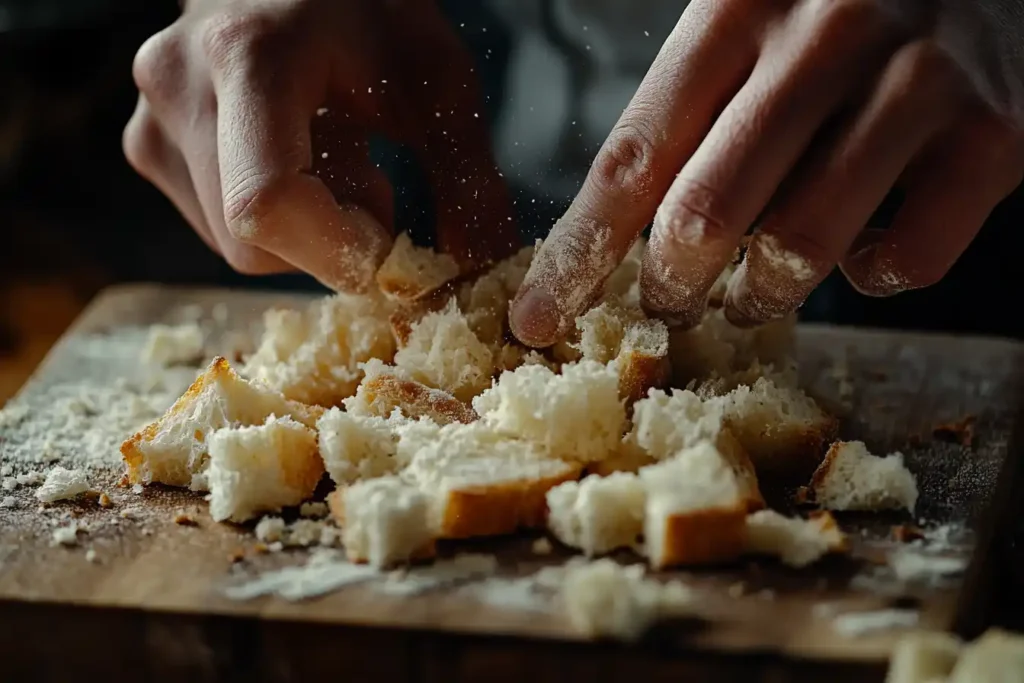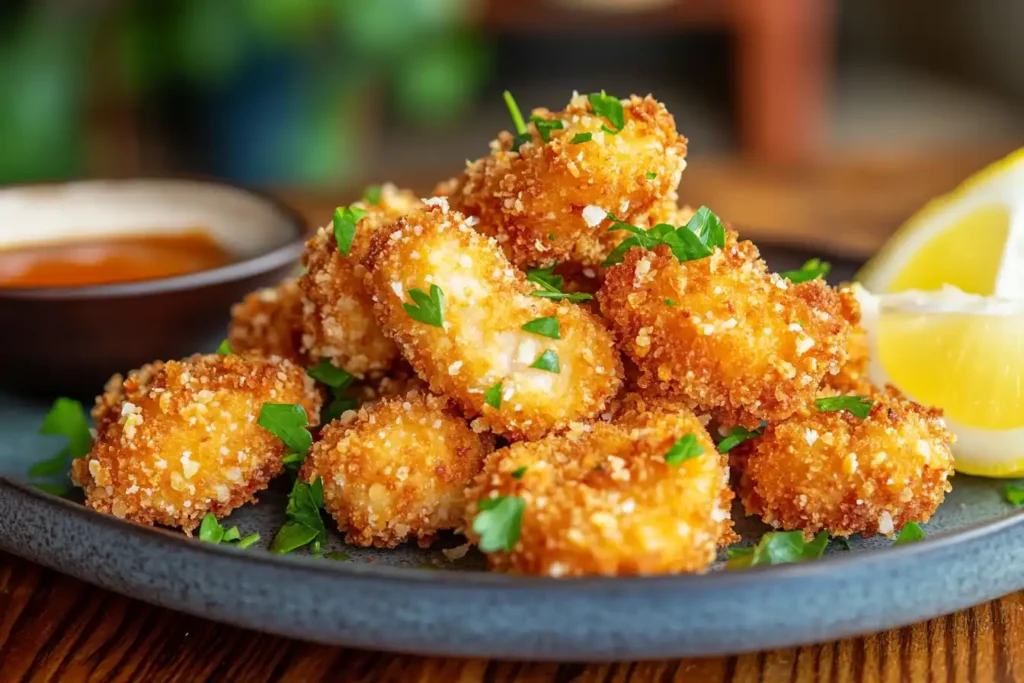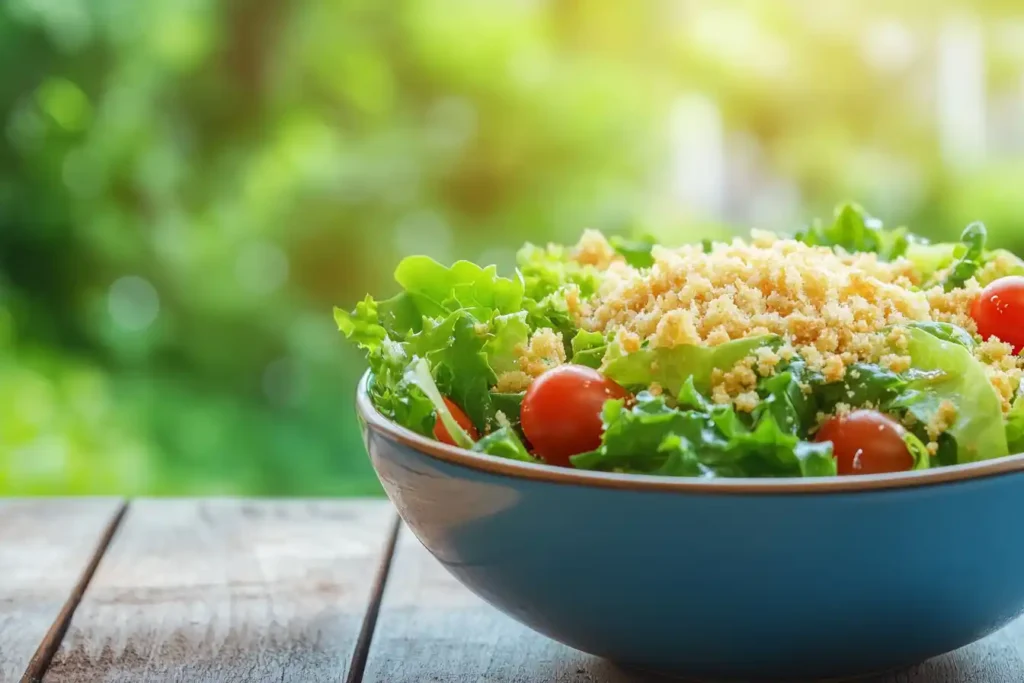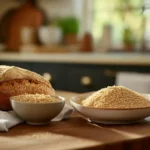There’s something truly magical about bread and crumbs. From golden, crispy coatings to rich, velvety textures in classic dishes, breadcrumbs are a secret ingredient that turns ordinary meals into extraordinary ones. Whether you’re looking to repurpose stale bread or enhance the crunch factor in your favorite recipes, mastering the art of making and using breadcrumbs is a game-changer.
In this article, we’ll explore everything from making homemade breadcrumbs to innovative ways to use them in cooking. You’ll discover timeless classics like bread pudding, crispy breaded chicken, and breadcrumb-stuffed vegetables, alongside creative modern uses. Plus, we’ll dive into global breadcrumb-based dishes, storage tips, and sustainable ways to reduce food waste. Let’s get started!
Understanding Breadcrumbs and Their Culinary Significance
Breadcrumbs might seem like a simple pantry staple, but they carry an impressive culinary legacy. From enhancing texture to binding ingredients together, these tiny bits of bread and crumbs play an essential role in both home kitchens and gourmet restaurants.
What Are Breadcrumbs?
Breadcrumbs are finely ground pieces of dried or fresh bread used in cooking and baking. They come in different varieties, including:
- Fresh breadcrumbs – Soft, delicate crumbs made from fresh or slightly stale bread.
- Dried breadcrumbs – Crunchy, coarse crumbs, often used for breading or as a thickening agent.
- Panko breadcrumbs – A Japanese-style breadcrumb that is light, airy, and incredibly crispy.
Each type serves a unique purpose, adding either crunch, structure, or a binding element to various dishes.
Culinary Uses of Breadcrumbs
Breadcrumbs are surprisingly versatile. They can:
- Create a crispy coating for fried and baked foods like chicken cutlets and fish fillets.
- Serve as a binding agent in meatballs, burgers, and meatloaf.
- Add a crunchy topping to casseroles, macaroni and cheese, or pasta dishes.
- Work as a thickener for soups, stews, and sauces.
- Elevate desserts like bread pudding by providing extra texture.
Historical Background of Breadcrumbs in Cooking
The concept of using breadcrumbs dates back centuries, when cooks sought ways to reduce food waste. In medieval Europe, breadcrumbs were often used to thicken soups and sauces. By the 19th century, they became a common ingredient in coating and frying foods. Today, breadcrumbs remain a kitchen staple, proving that simple, resourceful cooking techniques never go out of style.
How to Make Homemade Breadcrumbs

Creating your own homemade breadcrumbs is a simple and rewarding process. Not only does it help reduce food waste, but it also ensures you have fresh, flavorful crumbs on hand for various recipes.
Selecting the Right Bread for Breadcrumbs
Choosing the appropriate bread is crucial for optimal breadcrumbs:
- Freshness: While stale bread is commonly used, fresh bread can also be dried out for this purpose.
- Type: White, whole wheat, sourdough, or even gluten-free breads can be utilized, depending on the flavor profile you desire.
- Crusts: Removing crusts results in finer, more uniform crumbs, whereas leaving them on adds texture and color.
Step-by-Step Guide to Making Fresh Breadcrumbs
Follow these steps to craft fresh breadcrumbs:
- Preparation: Tear the bread into small pieces.
- Processing: Place the pieces into a food processor.
- Pulsing: Pulse until you achieve the desired crumb size.
- Usage: Use immediately or store in an airtight container in the refrigerator for up to a week.
Creating Dried Breadcrumbs: A Simple Process
For longer shelf life, dried breadcrumbs are ideal:
- Slicing: Cut the bread into thin slices.
- Baking: Arrange the slices on a baking sheet and bake at 250°F (120°C) for about 20 minutes, or until completely dry, flipping halfway through.
- Cooling: Allow the dried bread to cool.
- Processing: Break into pieces and pulse in a food processor to the desired consistency.
- Storage: Store in an airtight container in a cool, dry place for up to two months.
Seasoning Your Breadcrumbs for Added Flavor
Enhance your breadcrumbs by adding:
- Herbs: Dried oregano, basil, or parsley.
- Spices: Garlic powder, onion powder, or paprika.
- Cheese: Finely grated Parmesan adds a savory depth.
Mix the desired seasonings into the breadcrumbs thoroughly. Store seasoned crumbs as you would plain ones, but be mindful that additions like cheese may reduce shelf life.
Classic Recipes Utilizing Breadcrumbs
Breadcrumbs are a versatile ingredient, enhancing both texture and flavor in numerous classic dishes.
Traditional Bread Pudding: A Sweet Treat
Bread pudding transforms leftover bread into a delectable dessert:
- Ingredients: Cubed bread, milk or cream, eggs, sugar, vanilla extract, and spices like cinnamon or nutmeg.
- Method: Soak the bread cubes in the milk mixture until saturated. Transfer to a baking dish and bake until set and golden.
- Serving: Often enjoyed warm, sometimes with a drizzle of caramel sauce or a dusting of powdered sugar.
Crispy Breaded Chicken Cutlets

Breadcrumbs provide a satisfying crunch to chicken cutlets:
- Preparation: Pound chicken breasts to an even thickness.
- Breading: Dredge in flour, dip in beaten eggs, then coat with seasoned breadcrumbs.
- Cooking: Pan-fry in oil over medium heat until golden brown and cooked through.
- Tip: For extra crispiness, use panko breadcrumbs, known for their light, airy texture.
Homemade Meatballs with Breadcrumbs
Breadcrumbs act as a binder, keeping meatballs tender:
- Ingredients: Ground meat (beef, pork, or a mix), breadcrumbs, egg, minced onion, garlic, herbs, salt, and pepper.
- Method: Combine all ingredients gently to avoid overmixing. Shape into balls of desired size.
- Cooking: Brown in a skillet or bake in the oven, then simmer in tomato sauce until fully cooked.
Macaroni and Cheese with a Crunchy Breadcrumb Topping
Elevate this comfort food by adding a breadcrumb topping:
- Preparation: Prepare your preferred macaroni and cheese recipe.
- Topping: Mix breadcrumbs with melted butter and a pinch of salt.
- Baking: Sprinkle the breadcrumb mixture over the macaroni and cheese. Bake until the top is golden and crispy.
Incorporating bread and crumbs into these dishes not only enhances texture but also imparts a rich, satisfying flavor, showcasing the versatility of this humble ingredient.
Innovative Uses of Breadcrumbs in Modern Cuisine
Breadcrumbs have evolved beyond their traditional roles, finding new and exciting applications in contemporary cooking. Let’s explore some inventive ways to incorporate bread and crumbs into your dishes.
Breadcrumbs as a Salad Garnish

Adding toasted breadcrumbs to salads introduces a delightful crunch and depth of flavor.
- Preparation: Toast seasoned breadcrumbs in a skillet with a touch of olive oil until golden brown.
- Application: Sprinkle over mixed greens, Caesar salads, or roasted vegetable salads to enhance texture.
This simple addition can elevate a basic salad into a gourmet experience.
Incorporating Breadcrumbs into Pasta Dishes
Breadcrumbs can add a satisfying crunch to pasta, offering a contrast to its soft texture.
- Aglio e Olio with Breadcrumbs: Sauté garlic in olive oil, toss in cooked spaghetti, and finish with toasted breadcrumbs and red pepper flakes.
- Macaroni and Cheese: Top the dish with a mixture of breadcrumbs and melted butter before baking to achieve a crispy crust.
These methods provide a delightful textural contrast, enhancing the overall dining experience.
Using Breadcrumbs in Stuffed Vegetables
Breadcrumbs serve as a binding agent and add bulk to stuffing mixtures for vegetables.
- Stuffed Bell Peppers: Combine breadcrumbs with ground meat, herbs, and spices; fill halved bell peppers; and bake until tender.
- Zucchini Boats: Mix breadcrumbs with cheese and herbs, stuff into hollowed zucchini halves, and bake until golden.
This approach not only utilizes bread and crumbs effectively but also adds a hearty component to vegetable dishes.
Creating Breadcrumb-Based Desserts
Breadcrumbs can be a surprising yet effective ingredient in desserts.
- Chocolate and Breadcrumb Cake: Incorporate fine breadcrumbs into the batter to add moisture and a unique texture.
- Breadcrumb Pudding: Similar to bread pudding, use breadcrumbs soaked in milk, mixed with eggs, sugar, and spices, then baked until set.
These desserts showcase the versatility of breadcrumbs, transforming them into sweet treats.
Storing and Preserving Breadcrumbs
Proper storage of breadcrumbs ensures their longevity and maintains quality, allowing you to have this versatile ingredient readily available.
Best Practices for Storing Homemade Breadcrumbs
To keep breadcrumbs fresh:
- Airtight Containers: Place breadcrumbs in airtight containers to prevent exposure to air and moisture.
- Cool, Dry Place: Store the containers in a cool, dry pantry away from direct sunlight.
Following these steps helps maintain the breadcrumbs’ texture and flavor.
Extending Shelf Life: Freezing Breadcrumbs
For longer storage:
- Freezing: Place breadcrumbs in freezer-safe bags or containers, removing as much air as possible.
- Usage: When needed, take out the required amount and let them thaw at room temperature or use directly in cooking.
Freezing preserves breadcrumbs for several months without significant loss of quality.
Identifying Spoilage: When to Discard Breadcrumbs
It’s essential to recognize when breadcrumbs have gone bad:
- Smell: A sour or off odor indicates spoilage.
- Appearance: The presence of mold or discoloration is a clear sign to discard them.
- Texture: If breadcrumbs feel excessively hard or clumped together, it’s best to dispose of them.
Regularly inspecting stored breadcrumbs ensures food safety and quality in your dishes.
For more delicious recipes, check out our Slow Cooker Cheesy Chicken and Rice and Slow Cooker Tuscan Chicken Meatballs with Gnocchi.
Frequently Asked Questions (FAQs) about Breadcrumbs
People often have questions about bread and crumbs, especially regarding their meaning, uses, and storage. Below, we answer some of the most common inquiries.
What Does It Mean When Someone Says ‘Breadcrumbs’?
The term breadcrumbs can refer to both literal and figurative meanings. In cooking, it describes small pieces of bread used in various dishes. However, in a digital or conversational context, “breadcrumbing” refers to leaving hints or clues, like in website navigation or even relationships.
How to Store Homemade Breadcrumbs?
To store breadcrumbs properly:
Fresh breadcrumbs should be kept in an airtight container in the fridge for up to a week.
Dried breadcrumbs last longer when stored in a cool, dry place.
Freezing breadcrumbs extends their shelf life for up to six months.
Always check for mold or unpleasant odors before using stored crumbs.
What Is the Meaning of ‘Breadcrumbs’?
Besides their culinary definition, breadcrumbs can mean small bits of information left behind to guide someone. This concept is used in storytelling, online navigation, and even dating.
What Is ‘Breadcrumbs’ Slang For?
In slang, breadcrumbing describes giving someone small amounts of attention without serious intent, often in dating situations. The term originates from the idea of leaving a trail of crumbs.
Exploring Global Breadcrumb-Based Dishes
Breadcrumbs are a staple ingredient worldwide, appearing in traditional dishes across different cultures. From crispy coatings to hearty fillings, let’s explore how various cuisines make use of bread and crumbs.
Migas: A Spanish Delight
Migas is a classic Spanish dish made from day-old bread, garlic, and chorizo, cooked with olive oil.
- Preparation: Stale bread is torn into small pieces and sautéed with garlic and olive oil.
- Enhancements: Chorizo, peppers, and eggs can be added for extra flavor.
- Serving: Typically enjoyed as a hearty breakfast or tapa.
Migas highlight how simple ingredients can be transformed into a satisfying dish.
Semmelknödel: German Bread Dumplings
Semmelknödel are soft, round dumplings made from breadcrumbs and milk, commonly served with hearty stews.
- Ingredients: Breadcrumbs, milk, eggs, onions, and parsley.
- Cooking Method: Shaped into dumplings and boiled until firm.
- Pairing: Often served with mushroom sauces or roasted meats.
These dumplings are a prime example of using leftover bread and crumbs to create something delicious.
Pane Frattau: Sardinian Layered Bread
This Italian dish features thin, crispy flatbread soaked in tomato sauce, topped with cheese and a poached egg.
- Base: Uses pane carasau, a traditional Sardinian bread.
- Layers: Alternates soaked bread with sauce and cheese.
- Final Touch: A poached egg on top enhances the dish.
Pane Frattau is proof that simple, rustic ingredients can create an elegant meal.
These global dishes demonstrate the endless possibilities of bread and crumbs in different cuisines.
Nutritional Insights and Health Considerations
While bread and crumbs may seem like a simple ingredient, they offer nutritional value and can be adapted to fit various dietary needs. Whether you’re choosing whole grain options or looking for gluten-free alternatives, breadcrumbs can be a part of a balanced diet.
Caloric Content of Breadcrumbs
The calorie count of breadcrumbs depends on the type of bread used:
- White breadcrumbs – Around 100 calories per ¼ cup.
- Whole wheat breadcrumbs – Slightly higher in fiber, around 90-110 calories per ¼ cup.
- Panko breadcrumbs – Lighter and airier, typically containing fewer calories per serving.
Using homemade breadcrumbs allows you to control added ingredients, such as salt or preservatives, making them a healthier choice.
Whole Grain vs. White Bread Breadcrumbs
Whole grain breadcrumbs are a better option for those looking for added fiber and nutrients. They:
- Help improve digestion due to their fiber content.
- Provide more vitamins and minerals than white bread crumbs.
- Have a lower glycemic index, meaning they don’t spike blood sugar as quickly.
Choosing whole grain breadcrumbs instead of refined ones can enhance both taste and nutrition.
Gluten-Free Breadcrumb Alternatives
For those with gluten intolerance or celiac disease, several gluten-free options exist:
- Crushed rice cakes
- Almond flour-based crumbs
- Crushed cornflakes or gluten-free cereal
These alternatives provide the texture of breadcrumbs while keeping meals safe for gluten-sensitive individuals.
Sustainable Cooking: Reducing Waste with Breadcrumbs
Using bread and crumbs efficiently can help minimize food waste and make the most of ingredients you already have at home. Rather than throwing out stale bread, repurposing it into breadcrumbs is an easy and eco-friendly solution.
Utilizing Stale Bread Effectively
Instead of discarding stale bread, turn it into breadcrumbs for future use:
- Fresh breadcrumbs: Use stale bread as-is or process it into crumbs for soft-textured recipes.
- Dried breadcrumbs: Toast the bread before blending it into crispy crumbs for coatings or toppings.
- Stuffing and fillings: Add breadcrumbs to meatballs, casseroles, or stuffing mixtures to enhance texture and absorb moisture.
With just a little effort, leftover bread can be transformed into a useful ingredient rather than food waste.
Environmental Benefits of Homemade Breadcrumbs
Making breadcrumbs at home reduces packaging waste and unnecessary preservatives. Additionally:
- It lowers food waste, helping to reduce the environmental footprint.
- Homemade breadcrumbs avoid artificial additives found in many store-bought options.
- It encourages resourcefulness in the kitchen, making the most of available ingredients.
By repurposing bread and crumbs, home cooks can contribute to sustainable food practices while enhancing their meals with fresh, flavorful ingredients.
Print
Crispy Homemade Breadcrumbs Recipe
- Total Time: 30 minutes
- Yield: 4 cups of breadcrumbs 1x
- Diet: Vegetarian
Description
Transform leftover bread into golden, crispy breadcrumbs with this easy homemade recipe. Whether you’re making fresh, dried, or seasoned breadcrumbs, this method ensures a flavorful and versatile pantry staple for coatings, stuffings, and more.
Ingredients
- 4 cups of stale bread (white, whole wheat, or sourdough)
- 1 tbsp olive oil or melted butter (optional, for extra crispiness)
- ½ tsp salt (optional)
- 1 tsp dried herbs (optional, such as oregano, basil, or thyme)
- ½ tsp garlic powder (optional, for added flavor)
Instructions
- Prepare the Bread: Tear or slice the stale bread into small pieces.
- For Fresh Breadcrumbs:
- Place bread pieces in a food processor.
- Pulse until you reach the desired crumb size.
- Store in an airtight container in the refrigerator for up to 1 week.
- For Dried Breadcrumbs:
- Preheat oven to 250°F (120°C).
- Spread the bread pieces evenly on a baking sheet.
- Bake for 20-25 minutes, turning halfway through, until the bread is completely dry.
- Let cool, then process into fine crumbs using a food processor.
- For Seasoned Breadcrumbs:
- Mix dried breadcrumbs with olive oil, salt, herbs, and garlic powder.
- Store in an airtight container in a cool, dry place for up to 2 months.
- Use in Your Favorite Recipes: Perfect for breaded chicken, meatballs, casseroles, and pasta toppings!
Notes
- Best Bread Choices: White bread creates neutral, light breadcrumbs; sourdough and whole wheat add more depth of flavor.
- For Extra Crispiness: Toast breadcrumbs with a little olive oil in a skillet for a crunchier texture.
- Storage Tip: Freeze breadcrumbs for up to 6 months in an airtight bag to maintain freshness.
- Gluten-Free Option: Use gluten-free bread to make gluten-free breadcrumbs
- Prep Time: 5 minutes
- Cook Time: 20-25 minutes (for dried breadcrumbs)
- Category: Basics, Condiments, Dinner
- Method: Baking, Blending
- Cuisine: Global
Nutrition
- Serving Size: ¼ cup
- Calories: 110 kcal
- Sugar: 1g
- Sodium: 150mg (varies with added salt)
- Fat: 2g (if using oil or butter)
- Saturated Fat: 0.5g
- Unsaturated Fat: 1.5g
- Trans Fat: 0g
- Carbohydrates: 20g
- Fiber: 1.5g
- Protein: 4g
- Cholesterol: 0mg
Creative Breadcrumb Recipes to Try at Home
Now that we’ve explored the many uses of bread and crumbs, it’s time to put them into action with some creative, delicious recipes. These dishes showcase how breadcrumbs can enhance flavors and textures, making meals more satisfying.
Garlic-Parmesan Breadcrumb Crusted Fish
This recipe adds a crispy, flavorful crust to baked fish fillets.
Ingredients:
- 2 fish fillets (such as cod or tilapia)
- ½ cup panko breadcrumbs
- ¼ cup grated Parmesan cheese
- 2 cloves garlic, minced
- 1 tbsp olive oil
- 1 tsp dried parsley
- Salt and pepper to taste
Instructions:
- Preheat oven to 375°F (190°C).
- In a bowl, mix panko breadcrumbs, Parmesan, garlic, parsley, salt, and pepper.
- Drizzle olive oil over fish fillets and press the breadcrumb mixture onto the top.
- Bake for 15-20 minutes, or until the fish is flaky and the topping is golden brown.
- Serve immediately with lemon wedges.
Herb-Infused Breadcrumb Stuffing
This flavorful stuffing pairs well with roasted meats and holiday dinners.
Ingredients:
- 3 cups homemade breadcrumbs
- ½ cup butter, melted
- 1 small onion, finely chopped
- 2 celery stalks, diced
- 1 tsp dried thyme
- 1 tsp dried sage
- ½ cup chicken or vegetable broth
- Salt and pepper to taste
Instructions:
- In a skillet, sauté onion and celery in butter until soft.
- Stir in breadcrumbs, thyme, sage, salt, and pepper.
- Add broth gradually, stirring until moist but not soggy.
- Transfer to a baking dish and bake at 350°F (175°C) for 20 minutes.
Chocolate and Breadcrumb Cake
A surprisingly moist cake made with breadcrumbs instead of flour.
Ingredients:
- 1 cup fine breadcrumbs
- ½ cup cocoa powder
- ¾ cup sugar
- ½ cup melted butter
- 3 eggs
- 1 tsp vanilla extract
- ½ cup milk
Instructions:
- Preheat oven to 350°F (175°C).
- Mix breadcrumbs, cocoa powder, and sugar in a bowl.
- Whisk in melted butter, eggs, vanilla, and milk.
- Pour into a greased baking pan and bake for 25-30 minutes.
- Let cool before slicing.
These recipes prove that bread and crumbs can be the foundation of both savory and sweet dishes. Give them a try and elevate your cooking with the magic of breadcrumbs! 😊

Наш ресурс публикует актуальные новости разных сфер.
Здесь можно найти события из жизни, бизнесе и многом другом.
Материалы выходят ежедневно, что позволяет следить за происходящим.
Минималистичный дизайн ускоряет поиск.
https://beautydom-salon.ru
Каждое сообщение предлагаются с фактчеком.
Редакция придерживается информативности.
Следите за обновлениями, чтобы быть всегда информированными.